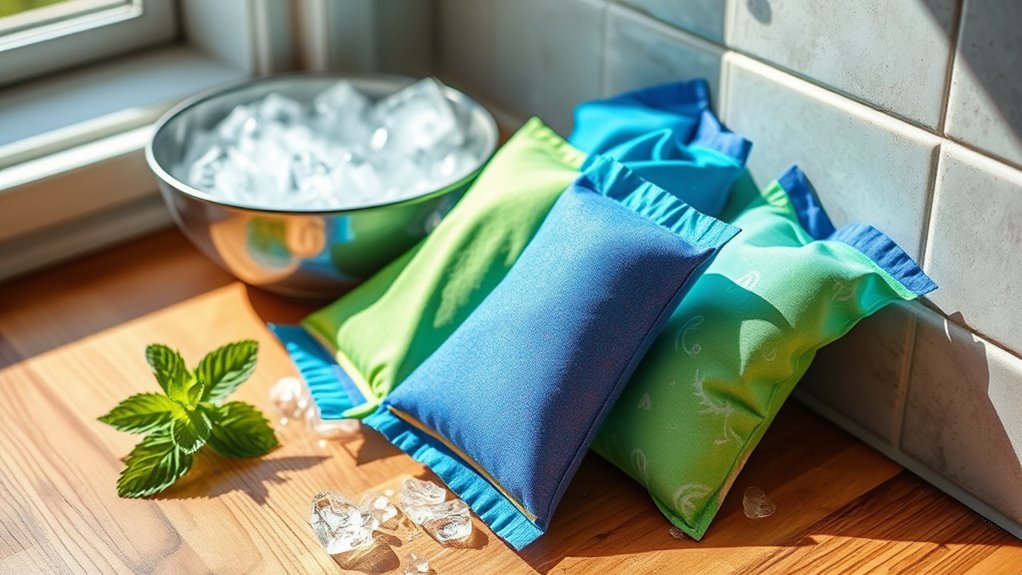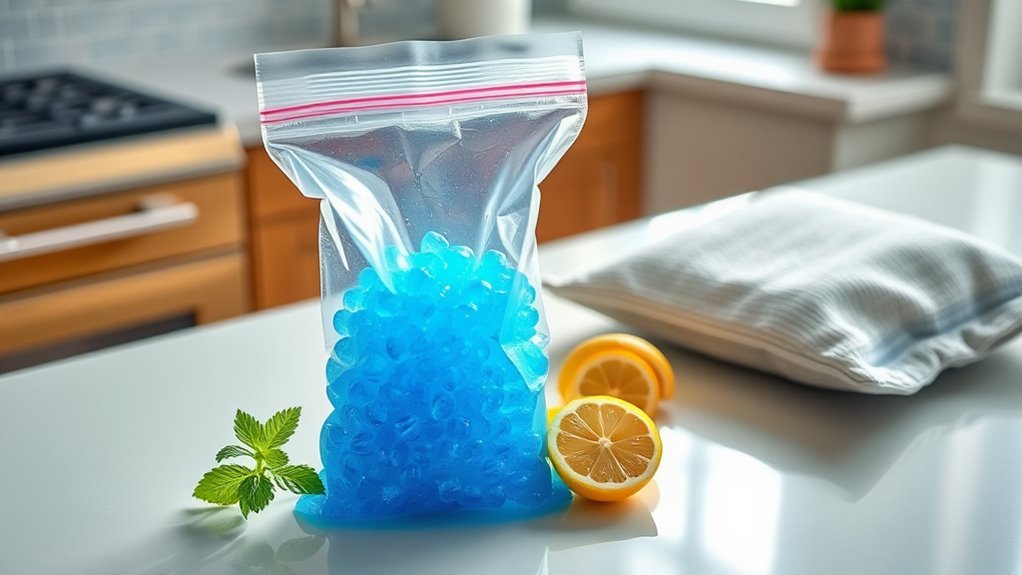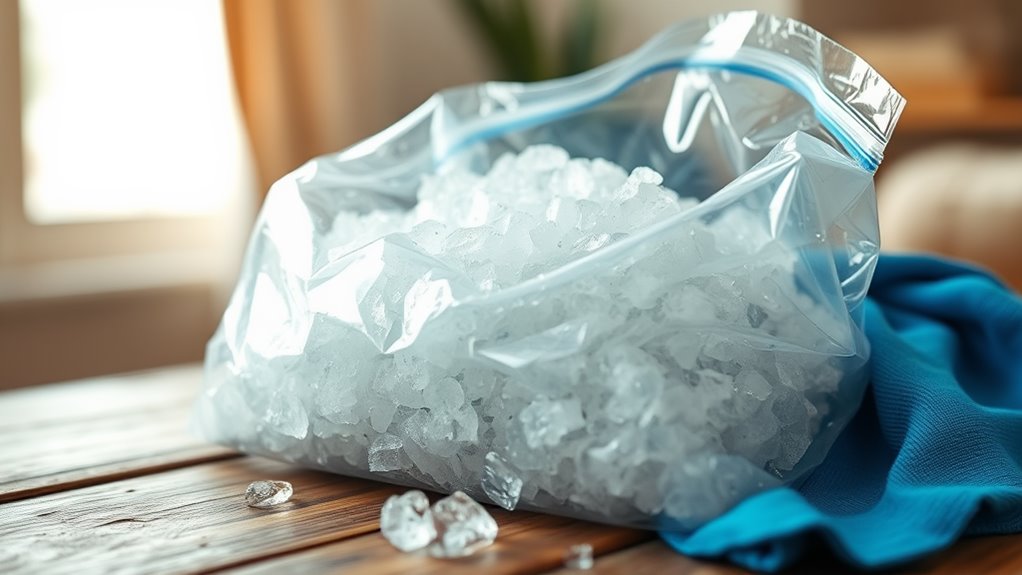DIY Ice Packs You Can Make in Minutes for Instant Pain Relief!
You can whip up DIY ice packs in minutes for instant pain relief! Just fill a resealable plastic bag with water and freeze it, or mix dish soap with water for a flexible option. If you’re in a pinch, grab frozen veggies from your freezer—they’ll mold to your body and provide relief. Don’t forget to wrap them in a thin cloth to protect your skin. Keep exploring to discover even more easy recipes and tips!
Benefits of Using DIY Ice Packs for Pain Relief
When you’re dealing with pain or swelling, using DIY ice packs can be a game changer. They’re cost-effective, easy to make, and highly portable, allowing you to address discomfort on the go.
You can customize the size and shape to fit any body part, providing targeted relief exactly where you need it. DIY ice packs can also be reusable, saving you money in the long run.
Unlike store-bought options, you can create them with common household items, making them readily available whenever you need them. Plus, applying cold therapy can reduce inflammation, numb sharp pain, and accelerate healing.
With quick access to a DIY ice pack, you’ll be better equipped to manage pain effectively and get back to your daily activities.
Simple Homemade Ice Pack Recipes
Creating simple homemade ice packs is an effective way to manage pain and swelling without spending much.
You can whip up these ice packs in just minutes using common household items.
Here are four easy recipes to try:
-
Plastic Bag and Water: Fill a resealable plastic bag with water, seal it, and freeze.
-
Dish Soap Ice Pack: Mix dish soap with water in a bag, freeze, and you’ll get a flexible ice pack.
-
Salt and Water: Combine water and salt in a bag for a slushy ice pack that molds easily to your body.
-
Rice Sock: Fill a sock with uncooked rice, tie it off, and freeze for a comforting, reusable ice pack.
These recipes provide quick relief when you need it most!
Using Frozen Vegetables as Ice Packs
Using frozen vegetables as ice packs is a clever and convenient solution for pain relief. You can grab a bag of peas or corn right from your freezer, and it’s ready to go in seconds.
The flexible packaging of these vegetables molds easily to your body, making them perfect for targeting specific areas like sore muscles or swollen joints. Just remember to wrap the bag in a thin towel to protect your skin from the cold.
Apply it for 15-20 minutes to reduce swelling and numb the pain. Plus, once you’re done, you can simply pop it back in the freezer for next time.
This method saves you money and offers instant relief without any hassle!
Herbal Compresses for Soothing Relief
Herbal compresses provide a natural and effective way to soothe pain and inflammation.
You can easily make these at home using common herbs and a bit of hot water. Here’s how you can create your own herbal compress:
-
Choose Your Herbs: Popular options include chamomile, lavender, or ginger for their soothing properties.
-
Prepare the Mixture: Steep your chosen herbs in hot water for about 10 minutes.
-
Soak a Cloth: Dip a clean cloth into the herbal infusion, then wring it out to remove excess liquid.
-
Apply the Compress: Place the warm, damp cloth on the affected area for 15-20 minutes.
These herbal compresses can provide comforting relief while promoting relaxation and healing.
Safety Tips for Applying Ice Packs
While herbal compresses can offer soothing relief, ice packs serve as a powerful tool for reducing swelling and numbing pain.
To use ice packs safely, always wrap them in a thin cloth or towel before applying them to your skin. This prevents frostbite and protects your skin from direct contact with the ice.
Limit your application to 15-20 minutes at a time to avoid skin damage. Take breaks of at least 20 minutes between applications.
If you experience increased pain, numbness, or skin discoloration, remove the ice pack immediately.
Finally, avoid using ice if you have certain conditions like Raynaud’s disease or circulatory issues; consult a healthcare professional if you’re unsure.
Stay safe while finding relief!
When to Seek Professional Help for Pain Management
Knowing when to seek professional help for pain management can make a significant difference in your recovery.
While DIY ice packs can relieve minor discomfort, certain situations call for expert guidance.
Here are four signs you shouldn’t ignore:
-
Persistent Pain: If your pain lasts longer than a few days despite home remedies.
-
Severe Pain: Experiencing intense pain that interferes with daily activities.
-
Swelling or Bruising: Noticeable swelling or bruising that worsens over time.
-
Numbness or Weakness: Feeling numbness, weakness, or loss of function in any part of your body.
Don’t hesitate to consult a healthcare professional when these issues arise.
They can provide the necessary evaluation and treatment tailored to your needs.
Frequently Asked Questions
How Long Can I Store Homemade Ice Packs in the Freezer?
You can store homemade ice packs in the freezer for several months. Just make sure they’re sealed tightly to avoid leaks or odors. When you need them, they’ll be ready to use whenever you are!
Can I Use DIY Ice Packs on Open Wounds?
You shouldn’t use DIY ice packs directly on open wounds, as they can cause irritation or infection. Instead, cover the wound with a clean cloth before applying the ice pack for safe relief.
What Materials Should I Avoid When Making Ice Packs?
When making ice packs, avoid materials like metal containers, which can cause skin burns, and any substances that aren’t safe for direct contact with skin. Stick to safe, flexible options like plastic or fabric.
How Often Should I Apply Ice Packs for Pain Relief?
You should apply ice packs for 15 to 20 minutes every hour as needed. This helps reduce swelling and numbs the pain. Just remember to take breaks to avoid skin damage and discomfort.
Are There Any Age Restrictions for Using Ice Packs?
There aren’t strict age restrictions for using ice packs, but you should monitor children and the elderly closely. Always ensure the ice pack’s not directly on the skin to prevent frostbite, regardless of age.





